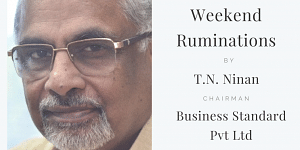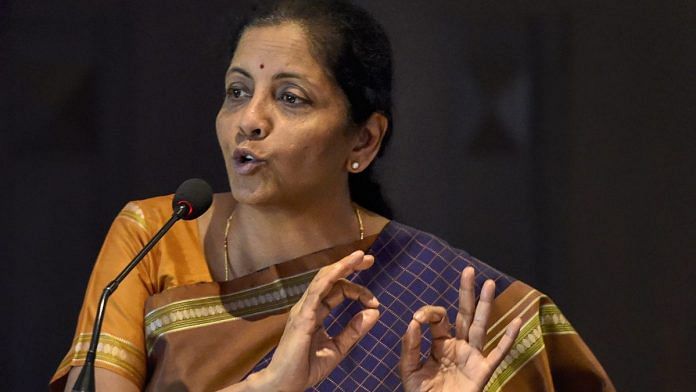Nirmala Sitharaman may have become the butt of jokes, but she has a point about app-based taxi services affecting car demand. Ola and Uber are reported to handle two million rides a day across the country. That could translate into anywhere up to half a million people finding a way to get by without owning cars — cumulatively, not suddenly. Add the reality of expanding metro systems (Delhi’s metro has 2.5 million riders daily), and people finally have real alternatives to car ownership. City bus systems (four million riders in Delhi) were not an alternative, being often slow and usually sweaty.
 Everyone can’t afford to tap into an app and summon a taxi. Most commuters in India’s cities are poor, and (Mumbai being the exception) walk to work, or get there on a bicycle. As you start up the income ladder, you get to afford a bus ticket. Metro rail and auto-rickshaws are meant strictly for the middle-class, as are motorbikes. Ola and Uber, though cheaper than tired yellow tops and “private” taxis, are still expensive. In other words, the users of app-based taxis would ordinarily be potential car buyers. But with the income and career uncertainties of the gig economy, many “millennials” prefer to avoid the financial commitment of car ownership. That is what the finance minister said.
Everyone can’t afford to tap into an app and summon a taxi. Most commuters in India’s cities are poor, and (Mumbai being the exception) walk to work, or get there on a bicycle. As you start up the income ladder, you get to afford a bus ticket. Metro rail and auto-rickshaws are meant strictly for the middle-class, as are motorbikes. Ola and Uber, though cheaper than tired yellow tops and “private” taxis, are still expensive. In other words, the users of app-based taxis would ordinarily be potential car buyers. But with the income and career uncertainties of the gig economy, many “millennials” prefer to avoid the financial commitment of car ownership. That is what the finance minister said.
It goes without saying that the slump in car demand is not just because of app-based taxis. Other factors are at work — the general economic slowdown, the financial sector’s travails that have affected car finance, the choice of many potential buyers to wait for cars compliant with stricter emission norms that kick in next April, and so on. The industry has added to its problems by pushing dealers to stock more and more vehicles. This clogged pipeline will have to be cleared before dealers can place fresh orders. In the interim, it exaggerates the drop in sales to dealers — which is what the industry reports. Some of these factors are specific to the sector and temporary, which is why no other product category has seen a comparable demand slump. It does not help that people also expect a cut in the tax on cars; why buy a car today if it might be cheaper next week?
Also read: Slowdown is choking Tamil Nadu auto hub, but talking about it can get workers fired
App-based taxis come with their own issues. They don’t mean less traffic, or less air pollution; if anything the opposite, because these cars are on the road all day. That would explain why cities in the West are thinking of capping the number of such taxis. On the other hand, think of Gurugram, which, like many smaller cities in India, has virtually no public transport other than one-and-a-half metro lines. App-based taxis save the day for large numbers of people who might otherwise have had to buy their own cars, including second cars in the family.
But the issue goes beyond taxis. For far too long, India has celebrated its auto industry and car ownership while neglecting public transport, not to mention pavements for walkers and lanes for cyclists — all of which any civilised city should have. The country needs to democratise its road spaces, and invest in public buses that are cheaper than metros.
One sympathises with car manufacturers struggling in a difficult market, but it is also obvious that they are milking the situation to try and wrest tax concessions from a harried government that already faces a tax revenue shortfall. To see why this is a questionable exercise, look at Maruti Suzuki’s finances. The company last year had a handsome pre-tax profit margin on sales of 12.6 per cent, with a mammoth Rs 36,500 crore parked as investments. The dividend pay-out has more than doubled over two years. The profit margins elsewhere in the industry are in some cases (e.g. Bajaj Auto and Eicher Motors) even better than Maruti Suzuki’s, while some like Mahindra & Mahindra and Ashok Leyland come in somewhat lower — but still better than the average for the manufacturing sector. If the industry’s stalwarts think car costs are too high for customers, why don’t they lower prices — which a good number of companies in the business can obviously afford to do?
By Special Arrangement with Business Standard
Also read: In Pune auto hub, an engineer is selling paan, another is roaming around with his CV




It is same like – because Auto is not expensive, people are not owning the Bike. These all absurd – there is no relationship between owning car and Ola/Uber. They are expensive as heck – 30 kms to and from take 1K from your pocket! Again most of the Car are entry level Indica which is old and not very comfortable.
I can’t understand what the author is trying to say? Is he saying that use of Ola and Uber led to crash in car sales. If this is the point, it would have been to give some relevant data points. The facts are:
1- The drop in car sales has been occurring this year only while Ola and Uber have been there for quite some time.
2- There is no evidence of a vast increase in their ridership this year.
3- An article in Economic Times titled “India to pull down global light vehicle sales for 2019” suggested that India is likely to have the maximum decline in automobile sales this year (-11.40% growth). Developed countries, where usage of cab hailing apps is likely to be higher due to greater smartphone penetration, are likely to see automobile sales growth in the range of -5.50% to 0.50%.
Given these facts, the decline in sales is likely due to lower purchasing power rather than use of cab hailing apps. Should the government bail the fat cats is another question and the answer to it lies partially in government’s role in creating the depressed economic atmosphere.
Has the print become the mouthpiece of the government ??? Trucks are not selling cause millennials aren’t buying it……. Really
Like Ashok above in comments pointed out that Reduced consumption is a precursor full blown econoMic recession……….
It is not just the state of the economy alone that has lead to the slowdown in truck sales. They are down also because of a combination of (1) removal of octroi and bringing of GST, which leads to shorter delivery time (2) increase in axel load, which means that the same truck can carry more load (3) better roads, which again leads to shorter delivery time (4) anticipation of discounts to clear BS IV stocks (5) lack of funding to the sectors by NBFCs.
One need to understand the difference between disruption and recession. The economies (not only India), going through changes. Economic knowledge of traditional approach will not help. What Uber and Ola is doing is disruption. Some of us want to paint differently. Someone was commenting in NDTV that India triggered global recession with GST and demonetization. There so many people around talk too much without knowing a thing. It was like Manmohan Singh was reading a script, without giving any effort to clarify what he really meant. And Modi haters will certainly have a field day. I once remembered P Chidambaram, then FM in 2013 saying GDP growth touching 5% is not alarming and now the same man showing 5 fingers, on his way to jail indicating he is worried for economy now.
According to your theory Mr Ninan, car makers should drop prices to boost sales. Isn’t that counter productive to the larger narrative.
Moreover, what is wrong if citizens, millennials particularly, want to preserve cash during tough times. Isn’t that normal, won’t corporates opt for it?
Metro Rail systems were introduced to ease urban mobility, reduce vehicle population, road congestion and pollution. It was bound to impact car sales at some point. If that has happened sooner than expected, prodded by a slowing economy, why make such a fuss about it.
In principle, there is nothing wrong if car sales plateau at a particular point. We need to have our city roads less crowded and less polluted . We need to cap our imports of crude oil too. The workers laid off by such slowing demand must be retrained into the services sector like health care, BPO, hospitality etc and these sectors must be encouraged to grow.
Believe one of the reasons for lower demand in CVs is the GST, which cut down the transit time by getting rid of Octroi and other hassles leading to better utilisation of the existing fleets.
Just as Ola /Uber make car owning that much less essential, particularly if one has no secure parking.
Despite this if the car makers are convince that reduction in GST will boost sales, they should reduce the prices to the extent they are seeking reduction and prove to the council, which will 100% agree to their demand. Why ask the council to take the risk ? The car owning has lost the status, just as the telephone, Fridge and many such symbols of the past.
Car sales – all automobiles, actually, including commercial vehicles and motor cycles – falling so dramatically was yet another indicator of the economy being in a mess. More hurtful because in a country where manufacturing is failing, this was one half of the sector. What provoked a reaction was that this was seen as an act of denial rather than the thoughtful analysis that is required. The fact that this was a straight lift from the WhatsApp forwards that are being synthesised for the faithful did not help. There is a growing pool of economic distress. People expect those in charge to be on top of things. Not Einstein or Newton in terms of intellect, but able to steer the economy to safer waters.
Are kahna kya chahte ho bhai? Either you are bhakt or khan market gang. Don’t try being diplomatic and justify both sides.
trying to look like a bhakt in lean season to increase viewers an will run pure propaganda in election season.
She is right as I don’t have 2 Cars parked in my garage at Mumbai.
The tendency to push new models with cosmetic upgrades, poor customer survey for what they desire, high operating costs, and also road congestion, paling issues – all are responsible in addition to Ola, Uber
Ola and Uber can hurt car sales where traffic jams and driving through unruly traffic are issues. Namely, in metro cities. Ola and Uber cannot substitute the ASPIRATIONS to own a “car”, which is still seen more as a status symbol and less as a mode of transport. Therefore, Nirmala Sitharaman is wrong in pretty much the entire India which is pretty much a collage of villages and small towns.